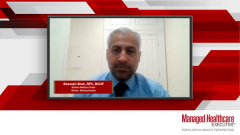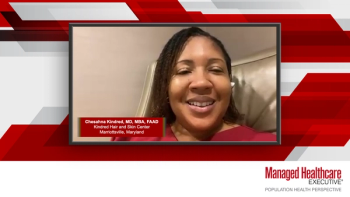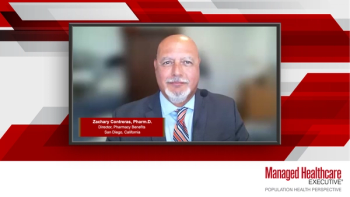
Cost-Benefit Analyses in Atopic Dermatitis
Considerations for quality measures established for atopic dermatitis when assessing how well patients are responding to treatment.
Episodes in this series

Peter A. Lio, MD: The main goals of therapy for every patient are three hurdles. The first hurdle is can I get you clear? We have to get the skin cleared up significantly. Honest to goodness, there are some patients where I’m having trouble. No matter what I throw, they’re so severe that I can’t even shut off the primary inflammation. That’s step one. Hurdle No. 2, can I keep you clear safely? That’s important because if somebody can stay clear but is using tons of steroids or taking oral immunosuppressants for long periods, this isn’t safe. Even though the disease has a lot of risks, the treatments start to outweigh the risks of the disease. We have to constantly balance this.
The third hurdle is more vague and a little harder to conceptualize: can the patient keep it up? This is a complex, multifaceted idea that includes everything from access to medications to lifestyle choices. Sometimes if the answer is phototherapy and coming to an office three times a week is safe and effective for them, they can’t keep it up because life is too busy. There are kids in the house or they have other meetings. There are many reasons why people are not able to keep it up, including things like they’re just exhausted from putting on all these creams all day and having a schedule. In each hurdle, we need to think, what can we do better for this given patient? Those are the goals of the treatment.
Bhavesh Shah, RPh, BCOP: There are four major goals. You have your biologic therapy, which a patient with moderate to severe atopic dermatitis is going to eventually be on. We know that it has to be related to this inflammatory path process that drives the disease itself, but we forget that there are other components, such as avoiding triggers, daily skin care, anti-inflammatory agents, and complementary modalities. These patients have a very cumbersome lifestyle where there are daily skin-care emollients they have to apply. There are recommendations to have baths with bleach to avoid Staphylococcus aureus colonization, so that needs to happen. There’s a specific temperature and humidity level they have to keep their house at. Even clothing that they have to wear to prevent exacerbation of irritation. It’s a multimodality approach: there are therapeutic drugs, complementary modalities, and supportive care that patients need to have. There are daily skin-care and some anti-inflammatory agents that are always going to be needed by these patients.
Peter A. Lio, MD: There are many considerations for payers to think about. No doubt, there are organizations like ICER [Institute for Clinical and Economic Review] that look at individual medicines and talk about their cost-benefit analysis, but it’s more complex than that. As a clinician, that’s what I do, and I work directly with patients and families. I implore payers to think about the clinician’s desires and goals and the patient’s well-being, and understand that not everybody reads the textbook, so to speak.
Another frustrating thing is when we have step therapies that make us do things that are inappropriate or irrational or that are not going to be reasonable for this patient. You’re trying to push back against a very large machine. Clearly, the purpose of these tools is to create steps, create barriers, and save costs. It’s OK—we can say that. You’re allowed to say that. It’s a business, and the way we’ve decided to do it—at this time, in this place—is to make medicine, for better or worse, a capitalistic endeavor to some degree. The companies have to make money. These payers are paying, and they have to watch their own budgets. That being said, it would be nice if there were more escape valves. If we could save time and energy for certain situations that arise and have an easier mechanism—a lot of times, the resources that go into getting even a relatively inexpensive medicine approved for a patient are staggering. We’re using my time and my staff’s time, going back and forth.
Meanwhile, the patient is suffering. They’re caught in the middle. Sometimes they’re mad at me and I’m saying, “I’m doing everything I can. I’ve written my letter. I’ve written the prescription. I’ve sent my chart notes. I don’t know what more to do.” From a doctor’s standpoint, I’ve already told the insurance company what we need, and now we’re playing the game. If they could just be more open to this, there are many ways to solve the problem from different tools. For example, there’s something called the Atopic Dermatitis Control Tool [ADCT]. It’s a free survey you can download. I use this with my patients sometimes. It’s a teaching exercise and an opportunity to ask good questions. There are six questions. It takes about a minute to go through. It’s no time at all, and you realize how many patients are not well controlled.
It’s been validated to help us get a sense of disease control. If we could show that if you just ask these questions, then maybe it wouldn’t take the doctor’s time. Wouldn’t it be neat if the insurance company had a question? They could work with their client, the person paying them. I don’t pay the insurance company. The patient pays the insurance company. If they could say, “Mr. so and so, your doctor says you need this medicine. I hear you. Can you just answer these six questions for me?” If it’s appropriate, “Holy cow—you’re right. Done.” Whatever it would take.
There’s clarity and some degree of universality, because we take a number of insurers, and every time it’s a new game. They have their own setup and their own thing. There are only so many hours in a day. There’s only so much bandwidth, especially for people who are taking care of a lot of patients. How can I know what’s going to happen with each medicine I write or each patient or each patient visit? It’s very complex. It would be nice to see some consortiums where people work together to say, “Here’s what we’re going to agree on. We’re going to make it relatively simple.” It can be strict but simple. We’d all trade strictness for simplicity because right now it’s a mess.
I think tools like the POEM score, the Patient-Oriented Eczema Measure, and its close cousin, the ADCT, are great places to start. Tremendously smart people have worked on these for years and studied them and validated them. Something like that would be great. Many insurance companies will mandate that we have to give some kind of a severity score, so that’s why I’ve gotten into the habit of putting my IGA [Investigator Global Assessment] score. It’s inappropriate and not right to ask for something like an EASI [Eczema Area and Severity Index] score, which paradoxically isn’t very easy. It’s difficult to do. If you’re not trained to do it, you’re going to get garbage in, garbage out. If you’re having somebody try to follow the thing and do it, then you’re supposed to be trained to do it. I can do it, but it takes time and energy, and I don’t think it’s appropriate for this sort of thing. Something like that would be fantastic.
For many of these medicines, I don’t think people are abusing them. This isn’t like a pain medicine, where people are trying to get eczema treatment. People are trying to get relief from their disease. I don’t understand ultimately why there are so many barriers to this because 99% of the time, I get through. It takes energy and time. We waste everybody’s time, and we get what we want. Can’t we just cut to the chase? Can we not just say, “You see my track record”? Maybe people don’t want this. There are probably some unintended consequences as I say this, but maybe there could be regional centers where it’s from this center. You’re a doctor that doesn’t see a lot of eczema cases. We’re not sure. We don’t feel comfortable with you approving this medicine. Can you send them to one of five centers around where this other person can approve it? Something like that. There’s probably a ton of bad things on that, but I’d trade simplicity and knowing what we need to do for the current labyrinth.
Ten years ago, I would’ve looked like an absolute superstar. The outcomes I would’ve picked are quality of life and happiness. I was doing great. Now I get tough cases from all over. I started focusing on it because I like it. I’m interested in it, and unfortunately my outcomes aren’t so great because I get difficult cases, and we do the best we can with them. I’m using everything I’ve got and sometimes bringing other people in—up to a seventh opinion—so I’d feel sad if they looked at me and said, “Dr. Lio stinks. He doesn’t get anybody better.” Wait a minute—we got the worst of the worst. Especially if there are capitation pipe setups or bonuses for people who spend less money, then it just makes you say, “Nope, I’m not seeing the hard cases.”
We already see this to some degree because for a patient with eczema, a new intake is at least 30 minutes face-to-face. There are hours that go unpaid—I’m in the background doing stuff or following up. Many offices will say, “Send it out. I don’t want to deal with it, because I can see a new patient with acne with a couple of pimples in five or 10 minutes. We can do the thing and keep moving.” The problem is, you then start to discriminate against the severity of the disease, and that’s not fair either. Everybody there loses eventually. Then you have a bunch of people who are turning and burning. People who are trying to do the right thing are getting penalized. To some degree, this already happens. The system already works this way, but it would really stink to make it even worse, to push it further in that direction.
Transcript edited for clarity.
Newsletter
Get the latest industry news, event updates, and more from Managed healthcare Executive.


















































